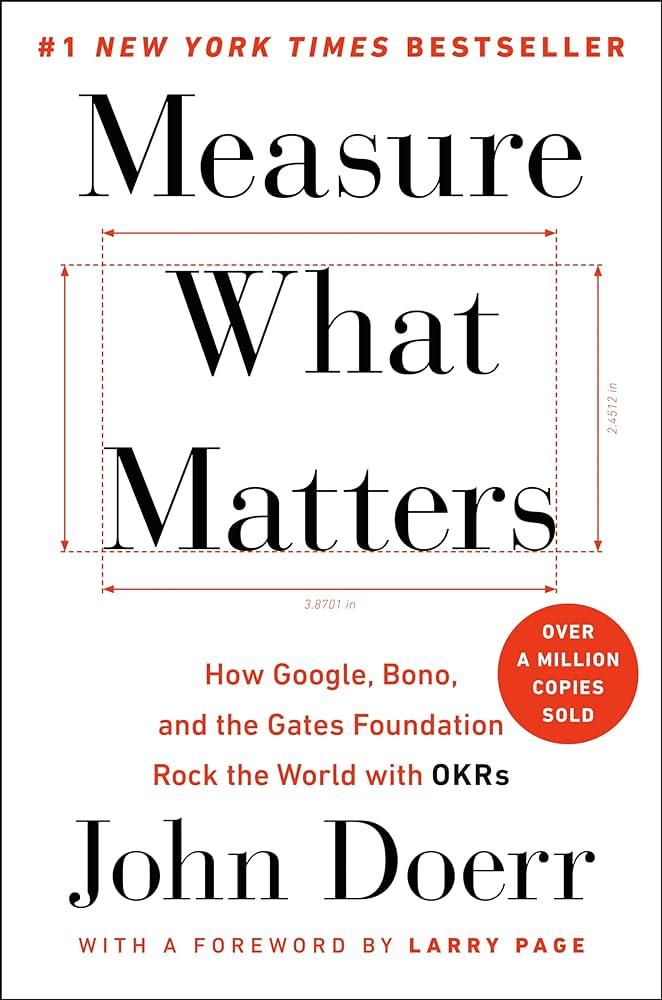- Tags:: 📚Books , ✒️SummarizedBooks , OKRs
- Author:: John Doerr
- Liked:: 2
- Link:: What Matters: Buy ‘Measure What Matters’
- Source date:: 2017-09-05
- Finished date:: 2024-06-22
- ISBN:: 978-0525536222
- Cover::

Why did I want to read it?
It’s the reference book on using OKRs.
What did I get out of it?
It’s one of the most shallow books I’ve read in a long time. Little protein, lots of “foundational myths” in the startup world. Awful.
As much as I hate process, good ideas with great execution are how you make magic. (p. xi)
There are so many people working so hard and achieving so little. (p. 19)
✍️ Déjame sin trabajo, por favor and 📖 The Square and the Tower:
more progressive model, mostly ignored at the time, was advanced by a Massachusetts social worker named Mary Parker Follett. In her essay “The Giving of Orders” (1926), Folleir proposed that power sharing and collaborative decision making between managers and employees led to better business solutions. Where Taylor and Ford saw hierarchy, Follett saw networks. (p. 24)
Turns out John Doerr follows the footsteps of Andrew S. Grove, who in turn follows Peter Drucker (p. 23)
Andrew Grove: when you are really high up in management, you’re teaching. (p. 38)
When you are putting out fires every day, it’s hard to build a next-generation billing technology. (p. 105)
The effect on accountability:
As a leader, you didn’t want to find yourself at the end of the quarter, standing in front of the company with a big red on the screen, having to explain why and how you failed. The pressure and discomfort of that experience made a lot of us do a lot of heroic things to avoid it. (p. 147)
Best practices OKRs
- As it appears in 📖 Peopleware 3rd Edition, that unlike MBOs (started by Peter Drucker), achieving OKRs should not be tied to performance evaluation. Otherwise people will not set ambitious goals.
- Less is more:
“A few extremely well-chosen objectives,” Grove wrote, “impart a clear message about what we say ‘yes’ to and what we say ‘no’to.” A limit of three to five OKRs per cycle leads companies, teams, and individuals to choose what matters most. In gen-eral, each objective should be tied to five or fewer key results. (p. 33)
- Starts with disciplined thinking at the top.
- Pair KRs: effect and counter-effect to safeguard quality.
- OKRs can be modified at any point in the cycle, or even scraped entirely.
- OKRs require lots of hand holding and time to make sure they are followed in an org.
OKRs require organization. You need a leader to embrace the process and a lieutenant to ride herd over scoring and reviews. (p. 157)
- OKRs are not cascaded (loss of agility). Top OKRs are published at the top, and teams build their own based on those. Since OKRs are transparent, if there is misalignement, it will become apparent.
- Scoring OKRs on a scale of 0 to 10, avergaging KRs:
- 0-3: Failed to make real progress.
- 0.4-0.6: Made progress but didn’t complete.
- 0.7-1: Completed.
- Additionally, you can self-assess (e.g., to account for changing circumstances).
- Distinguish between committed objectives (must be done at 100%) and aspirational (stretch) (you will fail 40% of times in average). Though some orgs like MyFitnessPal simplifies and does only committed ones (can afford fallbacks on moonshots).